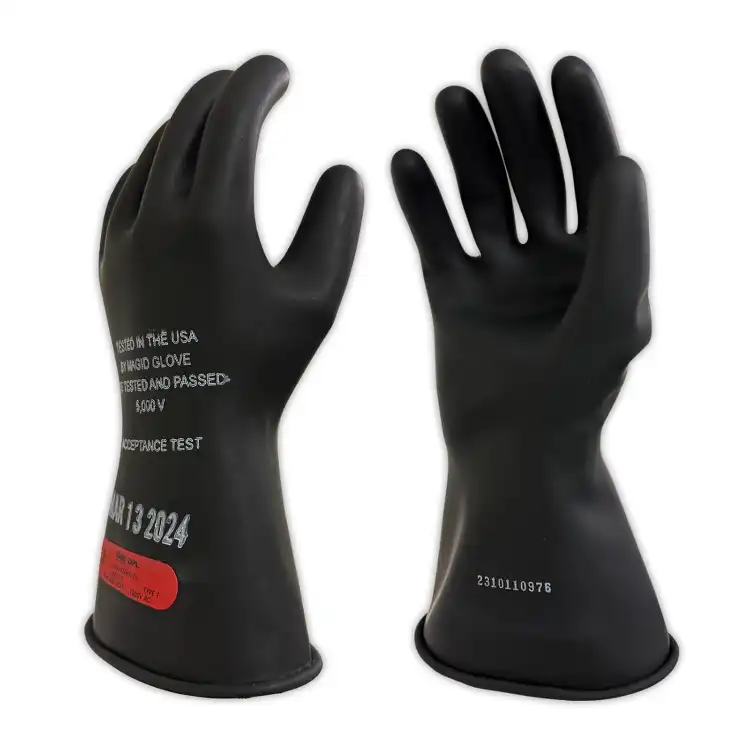Electrical Gloves
Electrical gloves are a critical piece of safety equipment for those working in industries where they may come into contact with live electrical components. These gloves are designed to provide a barrier between the worker’s hands and the electrical source, reducing the risk of electrical shock, burns, and other injuries. They are an essential part of a comprehensive approach to electrical safety, complementing other protective measures such as insulated tools and safety procedures.
While the primary function of electrical gloves is to protect against electrical hazards, they also offer other benefits. They can provide a good grip, reducing the risk of dropping tools or components, and they can also protect against cuts, abrasions, and chemical exposure, depending on the specific type of glove.
Understanding the different types of electrical gloves, their features, and how to choose and care for them is crucial for anyone who works with or around electricity. This guide will provide an in-depth look at electrical gloves, their importance, and how to select the right pair for your needs.
Our Top Electrical Glove Picks

Klein Tools 40074 Electricians Gloves Extra-Large
Check on AmazonKey Specs:
- Material: TPB 50%, Synthetic Leather 30%, Neoprene 20%
- Size: Extra-Large
- Color: Black
- Special Feature: Breathable
- Made in: USA and Imported
The Klein Tools 40074 Electricians Gloves are built for durability and comfort, combining materials like TPB, synthetic leather, and neoprene. The unique palm and finger design offer excellent slip resistance, making it easier to pull wire or cable. The extended cuff allows for easy on and off, while the wrapped index finger and reinforced thumb base ensure long-lasting use. Breathable spandex keeps your hands comfortable throughout long workdays. These gloves are a reliable choice for electricians looking for functionality and comfort.

MAGID Insulating Electrical Gloves
Check on AmazonKey Specs:
- Material: Dielectric Natural Rubber Latex
- Size: 8
- Color: Black
- Protection: Up to 1,000 Volts AC/1,500 Volts DC
- Compliance: ASTM D120-09, OSHA 29C FR 1910.269, NFPA 70E
The MAGID Insulating Electrical Gloves are a must-have for linemen and electrical contractors working in low-voltage environments. These Class 0 gloves offer protection up to 1,000 Volts AC, providing the perfect balance of elasticity and durability with their dielectric natural rubber latex construction. The 11” cuff length ensures extra protection past the wrist, and the straight cuff with a rolled edge keeps the gloves securely in place. These gloves meet stringent U.S. industry standards, making them a reliable choice for electrical safety.

SAS Safety 6468 Leather Protective Over Gloves For Electice Service Gloves, Large
Check on AmazonKey Specs:
- Material: Leather
- Size: Large
- Color: Multicolour
- Recommended Use: Electric service and manufacturing environments
- Features: Abrasion-resistant and durable leather construction
The SAS Safety 6468 Leather Protective Over Gloves are designed to offer exceptional durability and safety for those working in electric service environments. The high-quality leather construction ensures reliable protection against abrasions, cuts, and sparks, while the large size offers a comfortable fit for extended use. These gloves are ideal for preventing electrical hazards when working with power equipment, providing both flexibility and tough protection. The multi-color design adds a professional and stylish touch to your workwear.

Mechanix Wear: FastFit Tactical Gloves with Elastic Cuff for Secure Fit
Check on AmazonKey Specs:
- Material: Faux leather
- Size: Large
- Color: Brown
- Special Features: Touchscreen capable, breathable, elastic cuff, machine washable
- Use: Tactical, safety work, hunting, home improvement
The Mechanix Wear FastFit Tactical Gloves offer excellent durability and flexibility for various work and tactical environments. The synthetic leather material ensures strength and protection, while the touchscreen capability is perfect for use with mobile devices without compromising performance. The breathable TrekDry material keeps your hands cool and comfortable, even during extended use. The elastic cuff provides a secure fit, preventing gloves from slipping off. They’re also machine washable, making maintenance a breeze and ensuring longevity.

Klein Tools
Check on AmazonKey Specs:
- Material: Soft grain leather with reinforced palm and finger patches
- Size: Medium, Large, X-Large, 2X-Large
- Special Features: Padded knuckles, spandex back for flexibility
- Care Instructions: Hand wash
- Country of Origin: Made in the USA
The Klein Tools Lineman Gloves offer a perfect blend of durability and comfort. The soft grain leather construction, with reinforced palm and finger patches, ensures long-lasting protection and grip. Padded knuckles provide extra protection, making them ideal for tough tasks. The spandex back offers a comfortable, flexible fit that adapts to the hand, reducing fatigue during long hours of work. Plus, the classic Klein Lineman logo adds a touch of professionalism. A must-have for anyone needing reliable work gloves.
Understanding the Importance of Electrical Gloves
Electrical gloves are not just an optional accessory; they are a vital part of personal protective equipment (PPE) for electrical workers. Electricity can cause severe injuries, including electrical burns, shocks, and even electrocution. By providing an insulating barrier between the worker and the electrical source, electrical gloves can significantly reduce these risks.
Moreover, electrical gloves can also protect against secondary injuries. For instance, an electrical shock can cause involuntary muscle contractions, leading to falls or causing the worker to drop tools or equipment. By preventing the initial shock, gloves can also prevent these secondary accidents.
Finally, in addition to their safety benefits, electrical gloves can also improve work efficiency. They can provide a better grip, reducing the risk of dropping tools, and they can also protect against cuts and abrasions, allowing workers to handle components more confidently.
Different Types of Electrical Gloves
There are several types of electrical gloves available, each designed for specific applications and levels of electrical exposure. The two main categories are insulating gloves and non-insulating gloves. Insulating gloves, as the name suggests, provide protection against electrical shock by insulating the wearer from the electrical source. They are typically made of rubber and are rated for specific voltage levels.
Non-insulating gloves, on the other hand, do not provide protection against electrical shock, but they can protect against other hazards such as cuts, abrasions, and chemical exposure. They are often used in conjunction with insulating gloves, worn over the top to provide additional protection and extend the life of the insulating gloves.
Within these two categories, there are also different classes of gloves, rated for different voltage levels, and type I and type II gloves, which differ in their resistance to ozone. Understanding these different types of gloves is crucial for choosing the right glove for a specific task or environment.
Material Considerations for Electrical Gloves
The material of an electrical glove plays a crucial role in its protective capabilities. Most insulating gloves are made of rubber, which provides excellent insulation against electricity. However, there are different types of rubber, each with its own properties. Natural rubber provides good flexibility and tensile strength, while synthetic rubbers such as neoprene offer better resistance to chemicals and aging.
Non-insulating gloves can be made from a variety of materials, including leather, synthetic materials, and cut-resistant fabrics. The choice of material depends on the specific hazards that the glove needs to protect against. For instance, leather gloves can provide good protection against cuts and abrasions, while synthetic gloves can offer better resistance to chemicals.
When choosing an electrical glove, it’s important to consider not only the electrical protection it offers but also its resistance to other hazards. The glove material should be chosen based on the specific tasks and environment in which it will be used.
Size and Fit: Choosing the Right Electrical Gloves
Choosing the right size and fit for your electrical gloves is crucial for both safety and comfort. Gloves that are too small can be uncomfortable and restrict movement, while gloves that are too large can reduce dexterity and may not provide adequate protection.
Most manufacturers provide sizing charts for their gloves, which are based on the measurement of the hand circumference. To find your size, you can measure your hand around the widest part, excluding the thumb, and compare this measurement to the sizing chart. Some manufacturers also provide glove lengths, which can be useful for those with particularly long or short hands.
When trying on electrical gloves, make sure that they fit snugly but not too tightly. There should be enough room to move your fingers freely, but the glove should not be so loose that it can easily be pulled off. Remember that the fit may also be affected by whether you will be wearing liner gloves underneath.
Safety Standards and Certifications for Electrical Gloves
When choosing electrical gloves, it’s important to look for gloves that meet relevant safety standards and certifications. In the United States, electrical gloves should meet the standards set by the American Society for Testing and Materials (ASTM), which specify the design, performance, and testing requirements for electrical insulating gloves.
ASTM D120 is the standard for rubber insulating gloves, and it includes requirements for glove design, in-service care, and use. Gloves that meet this standard will be marked with the ASTM logo, the manufacturer’s identification, the size, the type and class of the glove, and the date of the test.
In addition to ASTM standards, electrical gloves should also be certified by a recognized testing laboratory, such as Underwriters Laboratories (UL) or the Canadian Standards Association (CSA). These certifications provide assurance that the gloves have been independently tested and found to meet the safety standards.
Voltage Ratings: Understanding the Levels of Protection
One of the most important factors to consider when choosing electrical gloves is the voltage rating. This rating indicates the maximum voltage that the gloves can protect against. It’s crucial to choose gloves with a voltage rating that is appropriate for the specific tasks and environments in which they will be used.
The voltage rating of electrical gloves is determined by the thickness of the insulating material. Thicker gloves provide higher voltage protection, but they also reduce dexterity. Therefore, it’s important to balance the need for protection with the need for flexibility and ease of movement.
It’s also important to note that the voltage rating is a maximum rating, and it does not guarantee protection against all electrical hazards. Other factors, such as the condition of the gloves and the presence of moisture or contaminants, can also affect the level of protection.
Insulation and Liner Options in Electrical Gloves
Many electrical gloves come with additional insulation or liner options to enhance their protective capabilities and comfort. For instance, some gloves have an inner liner made of cotton or another comfortable material, which can make the gloves more comfortable to wear and easier to put on and take off. Other gloves have an outer layer of leather or another durable material, which can provide additional protection against cuts, abrasions, and punctures.
Insulation can also enhance the electrical protection of the gloves. Some gloves have a double layer of insulating material, which can provide higher voltage protection. However, this can also make the gloves thicker and less flexible, so it’s important to consider the trade-off between protection and dexterity.
When choosing electrical gloves, consider the specific tasks and environments in which they will be used. If you will be working in cold conditions, for instance, you may want to choose gloves with thermal insulation. If you will be handling sharp objects, you may want to choose gloves with an outer layer of cut-resistant material.
Comfort and Dexterity in Electrical Gloves
While safety is the primary concern when choosing electrical gloves, comfort and dexterity are also important considerations. Uncomfortable gloves can be a distraction and can reduce productivity, while gloves that restrict movement can make it difficult to perform tasks accurately and efficiently.
The comfort of electrical gloves is largely determined by their fit and material. Gloves that fit well and are made of flexible materials can be more comfortable to wear for extended periods. Some gloves also have features such as padded palms or knuckle guards, which can enhance comfort.
Dexterity, on the other hand, is affected by the thickness and flexibility of the gloves. Thicker gloves provide better protection, but they can also make it harder to grip tools or manipulate small components. Therefore, it’s important to choose gloves that provide the necessary protection without unnecessarily compromising dexterity.
Maintenance and Care for Electrical Gloves
Proper maintenance and care are crucial for ensuring the longevity and effectiveness of electrical gloves. This includes regular inspections, cleaning, and storage.
Electrical gloves should be inspected before each use for signs of damage such as cuts, punctures, or signs of aging such as cracking or discoloration. If any damage is found, the gloves should be replaced immediately. Some gloves also have a date stamp, and they should be replaced when they reach their expiration date, even if they appear to be in good condition.
Cleaning is also important for maintaining the effectiveness of electrical gloves. Dirt, oil, and other contaminants can degrade the insulating material and reduce its protective capabilities. Most electrical gloves can be cleaned with mild soap and water, but always follow the manufacturer’s instructions.
Finally, proper storage is crucial for preserving the condition of electrical gloves. They should be stored in a cool, dry place, away from sunlight and heat sources. Some gloves come with a storage bag or box, which can protect them from damage and contamination.
Lifespan and Replacement of Electrical Gloves
The lifespan of electrical gloves depends on several factors, including the type of glove, the frequency of use, and the conditions in which they are used. However, even with proper care and maintenance, all electrical gloves will eventually need to be replaced.
One of the main factors that determine the lifespan of electrical gloves is the material. Rubber insulating gloves, for instance, can degrade over time due to exposure to ozone, heat, and other environmental factors. Therefore, they should be replaced every 6 months to 1 year, depending on the manufacturer’s recommendations.
The frequency of use and the conditions in which the gloves are used can also affect their lifespan. Gloves that are used daily in harsh conditions will need to be replaced more frequently than gloves that are used occasionally in mild conditions. Regular inspections can help to identify signs of wear and tear and determine when replacement is necessary.
Understanding the Limitations of Electrical Gloves
While electrical gloves provide essential protection for workers, it’s important to understand their limitations. No glove can provide 100% protection against all hazards, and the level of protection can be affected by various factors.
One of the main limitations of electrical gloves is that their protective capabilities can be compromised by damage or contamination. Cuts, punctures, or exposure to chemicals can degrade the insulating material and reduce its effectiveness. Therefore, it’s crucial to inspect the gloves regularly and replace them if any damage is found.
Another limitation is that the level of protection is determined by the voltage rating of the gloves. Gloves that are rated for a lower voltage cannot protect against higher voltages. Therefore, it’s crucial to choose gloves with a voltage rating that is appropriate for the specific tasks and environments in which they will be used.
Finally, it’s important to remember that electrical gloves are just one part of a comprehensive approach to electrical safety. They should be used in conjunction with other safety measures, such as insulated tools, safety procedures, and training.
Additional Features to Look for in Electrical Gloves
When choosing electrical gloves, there are several additional features that can enhance their functionality and comfort. These include features such as reinforced palms, knuckle guards, and adjustable cuffs.
Reinforced palms can provide additional protection against cuts and abrasions, making the gloves more durable and extending their lifespan. They can also provide a better grip, making it easier to handle tools and components.
Knuckle guards can provide additional protection for the knuckles, which can be vulnerable to impact and abrasion injuries. They can also make the gloves more comfortable to wear, especially when performing tasks that require a lot of hand movement.
Adjustable cuffs can make the gloves easier to put on and take off, and they can also provide a better fit. Some gloves also have a pull tab on the cuff, which can make it easier to pull the gloves on.
Tips for Using Electrical Gloves Safely
Using electrical gloves safely involves more than just putting them on. Here are some tips to ensure that you get the maximum protection from your gloves.
First, always inspect your gloves before use. Look for signs of damage such as cuts, punctures, or signs of aging such as cracking or discoloration. If any damage is found, do not use the gloves. Also, check the date stamp and replace the gloves if they have reached their expiration date.
Second, make sure that your gloves are clean before use. Dirt, oil, and other contaminants can degrade the insulating material and reduce its protective capabilities. Most gloves can be cleaned with mild soap and water, but always follow the manufacturer’s instructions.
Finally, always use your gloves in conjunction with other safety measures. This includes using insulated tools, following safety procedures, and receiving proper training. Remember that electrical gloves are just one part of a comprehensive approach to electrical safety.
Conclusion: Making an Informed Decision When Buying Electrical Gloves
Choosing the right electrical gloves is a crucial decision that can significantly impact your safety and productivity. By understanding the different types of gloves, their features, and how to choose and care for them, you can make an informed decision that meets your specific needs.
Remember to consider factors such as the voltage rating, the material, the size and fit, and the safety standards and certifications. Also, consider additional features such as reinforced palms, knuckle guards, and adjustable cuffs, which can enhance the functionality and comfort of the gloves.
Finally, remember that electrical gloves are just one part of a comprehensive approach to electrical safety. They should be used in conjunction with other safety measures, such as insulated tools, safety procedures, and training. By taking a comprehensive approach to electrical safety, you can significantly reduce the risk of electrical injuries and accidents.
Frequently Asked Questions about Electrical Gloves
Here are some frequently asked questions about electrical gloves.
How often should I replace my electrical gloves?
The lifespan of electrical gloves depends on several factors, including the type of glove, the frequency of use, and the conditions in which they are used. However, even with proper care and maintenance, all electrical gloves will eventually need to be replaced. Rubber insulating gloves, for instance, should be replaced every 6 months to 1 year, depending on the manufacturer’s recommendations.
Can I clean my electrical gloves?
Yes, most electrical gloves can be cleaned with mild soap and water. However, always follow the manufacturer’s instructions. Dirt, oil, and other contaminants can degrade the insulating material and reduce its protective capabilities, so regular cleaning is important.
What should I do if I find damage on my gloves?
If you find any damage on your gloves, such as cuts, punctures, or signs of aging, you should replace them immediately. Even minor damage can compromise the protective capabilities of the gloves.
Can I use electrical gloves for other hazards?
While electrical gloves are primarily designed to protect against electrical hazards, they can also provide protection against other hazards such as cuts, abrasions, and chemical exposure, depending on the specific type of glove. However, always make sure that the gloves are suitable for the specific hazards that you are facing.
Do I still need to use insulated tools if I’m wearing electrical gloves?
Yes, electrical gloves should be used in conjunction with other safety measures, such as insulated tools. While gloves provide protection for your hands, insulated tools provide protection for other parts of your body. Remember that electrical safety requires a comprehensive approach.
